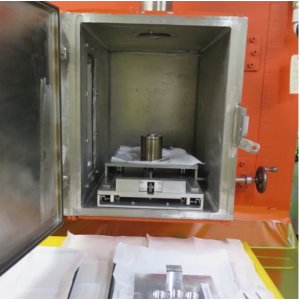
by Lucas Johnson
In the fall of 2017, a pair of curious Vanderbilt students approached Steve Krahn, professor of the practice of nuclear environmental engineering and a former Department of Energy official, to discuss novel ways of using nuclear energy to power aerospace vehicles. Their hypothesis was that utilizing nuclear powered propulsion would decrease carbon emissions while increasing endurance of aerospace vehicles, such as commercial aircraft.

Krahn understood the allure inherent in their questions, but quickly cautioned them about the immense challenges they would face in commercializing such a technology. In particular, he pointed to the failed Nuclear Energy for Propulsion of Aircraft (NEPA) program, which began at Oak Ridge National Laboratory in 1946 and was canceled by the Kennedy administration by 1961.
“It’s not the function of the professor to rain on people’s parade, but I made it a learning experience for them,” Krahn says. “I shared some of the historical documents of that program. We had weekly assignments that they reviewed. And so, by the end of that fall semester, we were starting to look at alternative options.”
Tyler Bernstein and Jonathan Segal, BS’19, would soon find their focus after connecting with fellow Vanderbilt student Jake Matthews, MS’18, who was getting his master’s in mechanical engineering and exploring ways to convert the decay of nuclear material into electricity. Radioisotope power systems, or RPSs as they’re known, resemble extremely long-acting batteries.

NASA has employed RPSs for more than two dozen space missions because of their ability to produce heat and electricity under harsh conditions in deep space for decades without any maintenance or refueling. However, these RPSs have used plutonium-238 (Pu-238), which is so rare and expensive that NASA can only fly between one to two missions per decade using the technology.
But Bernstein, Segal, and Matthews are working hard to change that. With guidance from Krahn and Vanderbilt’s Wond’ry, they launched Zeno Power, which has developed a commercially available RPS that uses strontium-90 (Sr-90), a nuclear waste material, rather than the rare Pu-238. Zeno recently announced that it completed testing of its first Sr-90 heat source at Pacific Northwest National Lab, a key milestone for the company to begin delivering RPSs to customers in 2025.
The U.S. Government deployed Sr-90-fueled RPS in remote terrestrial and maritime environments in the 20th century, but encountered issues with weight and efficiency constraints using legacy systems. Zeno’s RPS overcomes these challenges by employing an innovative fuel form and shielding that reduces the mass of its systems compared to legacy Sr-90 RPSs.
In a recent interview with SpaceNews, Bernstein, who is the company’s CEO, describes the device as being the size of a microwave oven and capable of generating electricity for decades. “It’s really hot rocks in a box,” he told the publication.
Krahn adds that Sr-90 is officially categorized as nuclear waste and there’s an abundance of it. The Department of Energy has significant inventories of the material at various sites around the country, which Zeno is presently working to gain access to.
“Zeno is working to transform this legacy waste material into a valuable resource for carbon-free energy production in grid-less environments,” says Krahn, who is still active with the company and serves as Chief Safety Advisor on Zeno Power’s advisory board.
The novel application is already attracting significant attention from major government and commercial investors. Zeno, which has a team of 35 and offices in Washington, D.C., and Seattle, Washington, recently won a $30 million contract from the U.S. Department of Defense to design and build the first commercially developed RPS-powered satellite by 2025.

And in September, NASA announced that Zeno Power would lead a team that will receive $15 million to develop a space-ready radioisotope Stirling generator for future lunar surface applications, such as during NASA’s Artemis missions. Artemis is intended to reestablish a human presence on the moon; people were last there more than 50 years ago.
Most recently, Zeno was awarded a $7.5 million contract from the Department of Defense to build and demonstrate an RPS for seabed use by the U.S. Navy, enabling future applications such as long-endurance sensors and charging stations for autonomous undersea vehicles.
Zeno also recently announced that it, along with DOE, is collaborating with the Oak Ridge Office of Environmental Management (OREM) and UCOR, LLC in a public-private partnership to repurpose legacy radioactive material as a clean-energy fuel source.
“When we walked into Dr. Krahn’s office six years ago, we had every expectation that he would tell us to stop pursuing this idea,” Bernstein said. “Instead, he took the opportunity to mentor us, providing us with invaluable knowledge about the nuclear industry. Today, we’re on-track to build the first commercially developed RPS – enabling access to power from the seabed to the lunar surface.” Bernstein added, “sometimes we wonder what would’ve happened if he hadn’t responded to our (cold) email!”